By Ana Caballero
Feet – what do I need you for when I have wings to fly?
– Frida Kahlo
Wings have long been associated with a poetic dimension, one of fantasy, freedom and elevation. Insects, on the other hand (at least in the western mindset), connote something much lower; they are an object of dislike and disgust. So it is ironic that one of the keys of success for the insect world – with over a million named species – has been the evolution of flight [1].
This sturdy yet elegant structure has provided great inspiration to biomimetic engineers – recently, for example, studies of the desert locust wing have lead to new kinds of design for lightweight aircraft vehicles [2].
Although from a biomimetic perspective the locust wing proves fascinating, at the Lab we are more interested in its constitution for consumability than for performance.
The month of April was all about insects. In pursuit of understanding the culinary potential of something so novel in our diet, we began by questioning our most basic assumptions about the ingredient. And when it comes to food, one of the fundamental distinctions is to understand which parts of a material are good to eat and which are not. Hence the recurring dilemma, captured in the video below: https://vimeo.com/66187451
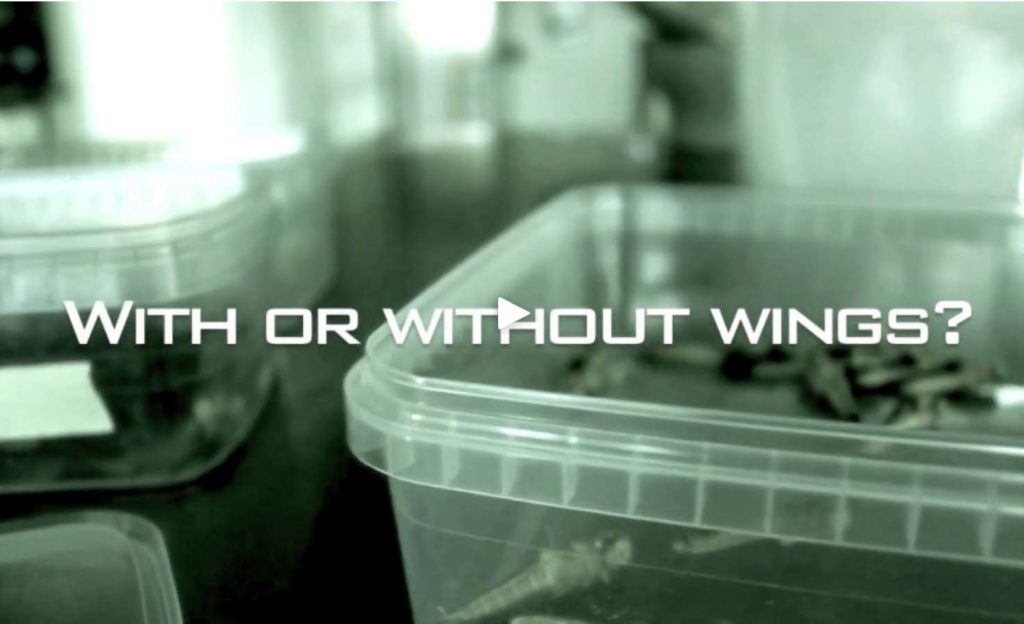
Although this chat between Ben and me seemed somewhat frivolous, the fact was I had no clue about the edible properties of this curious structure. So after some readings on the weekend, this is what I found.
The insect wing is composed primarily of cuticle that is arranged into tubular, supporting veins and thin connecting membranes. The veins are typically hollow tubes that transmit fluid, oxygen, and sensory information via nerves. The cuticle itself is a multi-layered material of chitin microfibers embedded in a protein matrix [2].
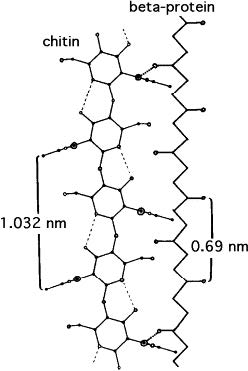
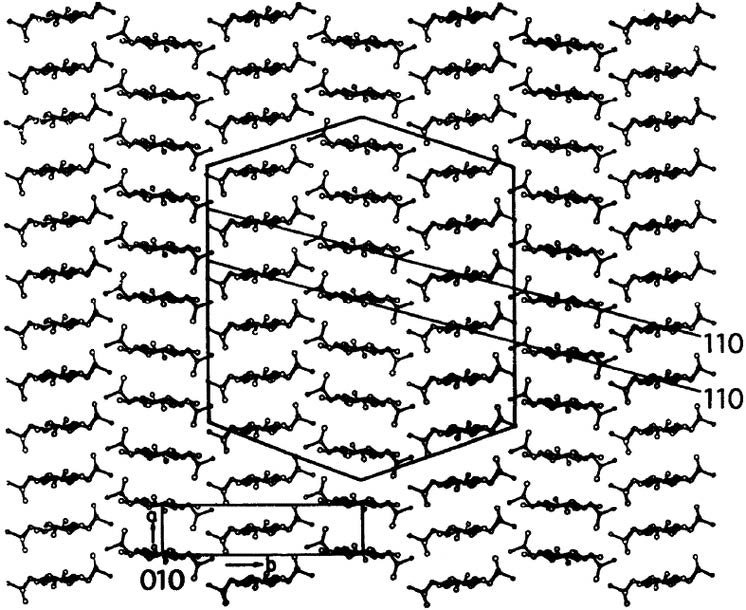
Chitin is a carbohydrate polymer – supposedly the most abundant in nature, beyond even cellulose – found in invertebrate exoskeletons, protozoa, fungi, and algae [3]. Chitin is broken down by chitinase, an enzyme that breaks the glycosidic bonds between individual carbohydrate molecules. In the past it was assumed that humans did not possess this enzyme and therefore could not digest chitin [4]. Yet the recent discovery of chitinolytic enzymes produced by human gastrointestinal bacteria has overturned this assumption [5]. Overall, the cuticle proves as well to be a high source of dietary fiber.
This composition applies not only to the wings but to all the exoskeleton. Seeing that the wings are only a small part of the whole organism, they would not be missed if they were removed. In fact, they may even pose a danger to the eater. Some research points out that the sturdy wings and legs of insects of the order Orthoptera (which includes locusts) could puncture or lodge themselves in the intestinal tract, as they have been observed to do in certain animals [6]. Incidentally, most papers that review the cooking procedures of insects in cultural context also observe wing removal in practice. The removal could be due to matters of preference or traditional knowledge related to these possible health hazards, even if the chitinous cuticle is in fact digestible and contains potential nutrients for the human eater.
Thailand provides plenty of examples where locals have used their traditional knowledge to collect and cook many insects such as crickets, cicadas and Dung beetles. Regardless of the variety, the wings and hard exoskeletons are usually removed before cooking. The delicacies are usually deep-fried, grilled over an open fire, parched and ground, or steamed in banana leaves and curried [6].
Although removal is common, it is not a hard rule. So what settled this debate, at least in the lab and for the Desert Locust (Schistocerca gregaria) we were dewinging in the video, was to consume it as a hopper (non-flying nymph). Our preference had less to do with its underdeveloped wing formation and more to do with its particular morphological characteristics at that developmental stage:
Desert Locust (Schistocerca gregaria)
5th instarnymph (Locust life cycle)
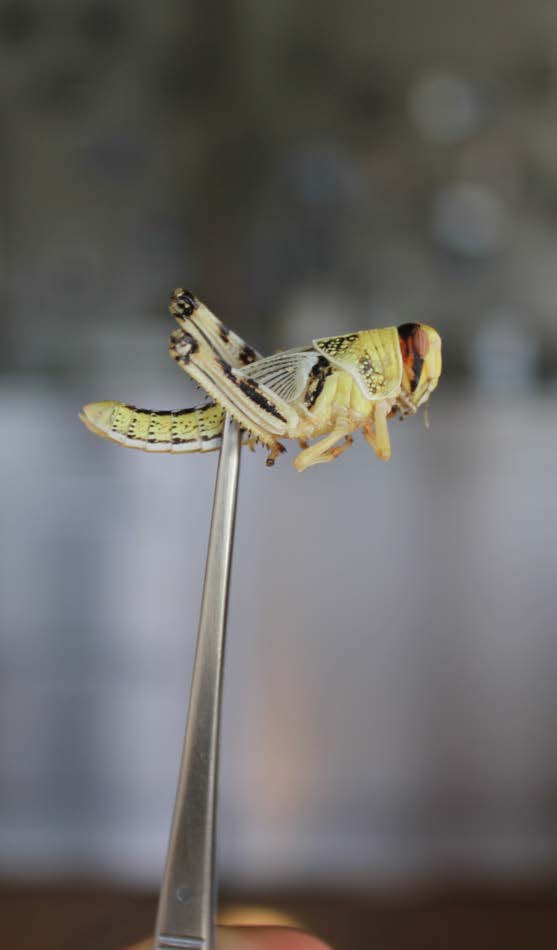
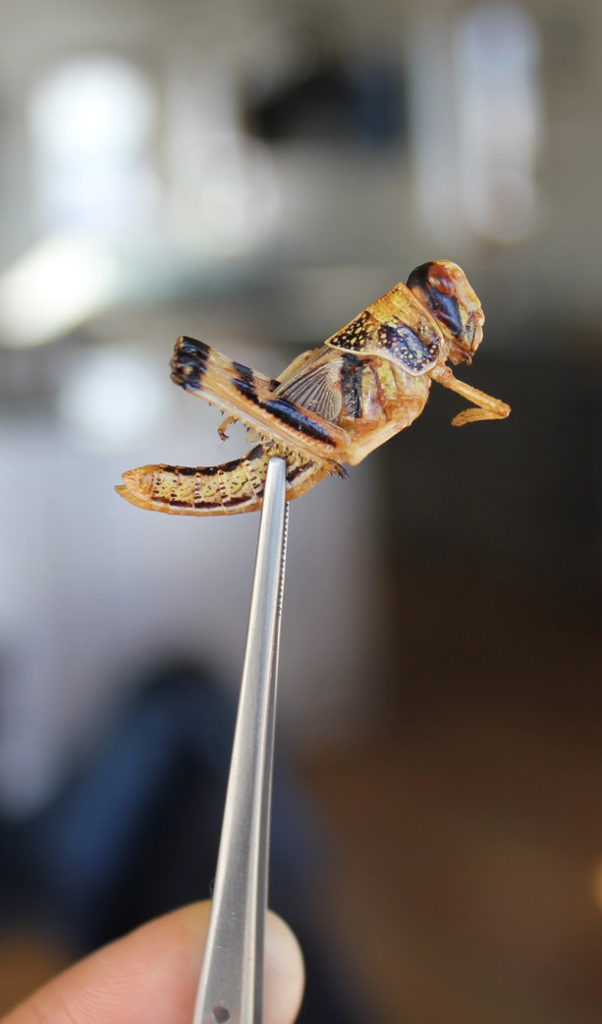
Presence of original color pattern with additional golden brick coating. Crisp, nutty, and slightly sweet with a vegetable note.
At this time of the year, lacto-fermented rhubarb with dill pairs nicely with this crunchy treat. Along with a good beer, it has proven a perfect aperitivo for sunny evenings on the harbor.
NB: Please share any examples you might know of where fully developed wings are not discarded.
1. Combes, S.A. ”Materials, Structure, and Dynamics of Insect Wings as Bioinspiration for MAVs.” Encyclopedia of Aerospace Engineering. 2010.
2. Dirks, J.H & Taylor, D. Veins. ”Improve Fracture Toughness of Insect Wing.” PLoS ONE. 7.8 (2012).
3. Belluco, S. et al. ”Edible insects in a food safety and nutritional perspective: a critical review.” Comprehensive reviews in food science and food safety. 12, 2013.
4. Dufour, D.L. ”A case study from the northwest Amazon.” American Anthropologist, New series. 89.2 (1987): 393-7.
5. Rumpold B. & Schlüter O.K. ”Nutritional composition and safety aspects of edible insects.” Molecular Nutrition & Food Research. 57 (2013), 802–23.
6. Food and Agriculture Organization of the United Nations. ”Edible forest Insects, Humans bite back!” RAP Publication: 2010.
7. Julian, Vincent, and Wegst, Ulrike. ”Design and mechanical properties of insect cuticle.” Arthropod Structure & Development . 33.3 (2010), 187-99.
